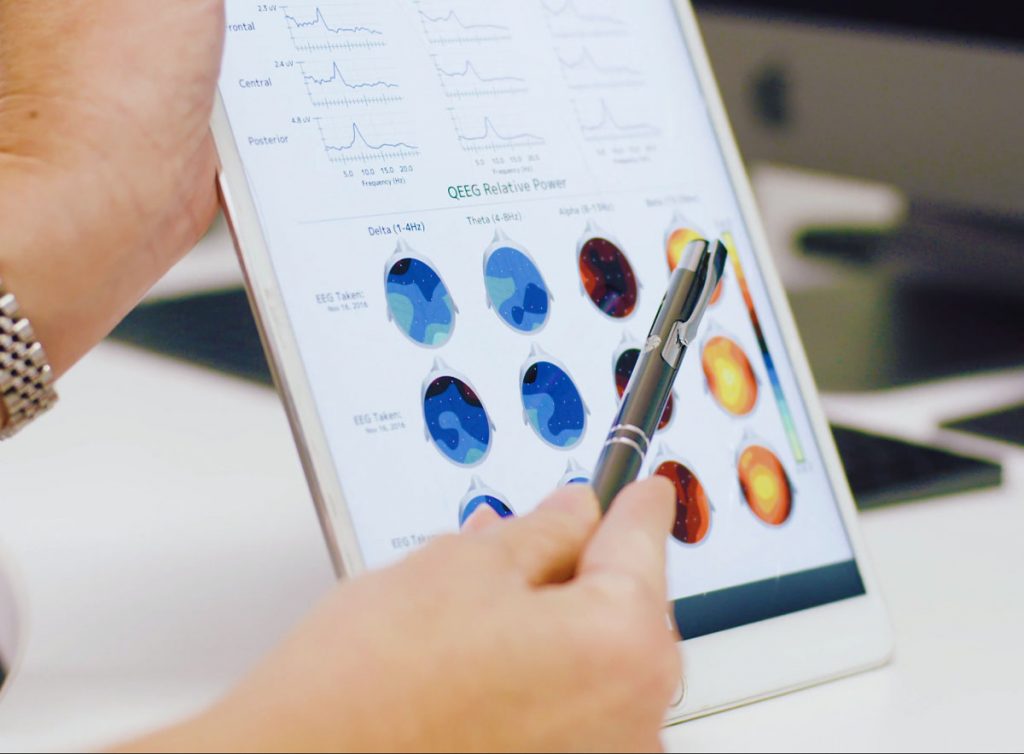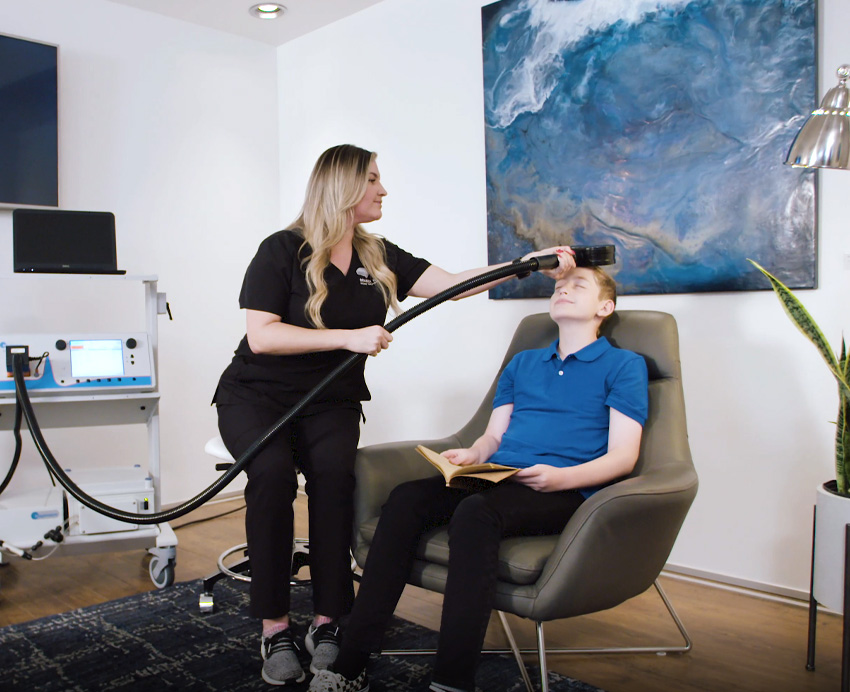
MeRT for Autism
Drug-free, non-invasive, and gentle,
MeRT can be life-changing for patients
with Autism Spectrum Disorder.
MeRT Treatment for Autism
MeRT is a new, non-invasive treatment for autism that works to improve brain communication. As autism spectrum disorder (ASD) is a developmental disability caused by differences in the brain, it makes sense that treatments to improve brain communication can help ease autism symptoms.
That’s precisely what MeRT does, focusing on the unique brain activity of each patient diagnosed with autism. And while two people may have the same autism diagnosis, their behaviors can be very different. That’s why a targeted brain treatment protocol like MeRT can work so well.
Can Autism be Cured with Therapy?
There is no cure for autism and no one-size-fits-all treatment. ASD is a complicated condition that presents differently in each person. However, therapy is a vital part of helping someone with ASD manage symptoms, improve communication and learning skills, and live a higher quality of life.


What is the Best Treatment for Autism?
While there is no cure for autism, many treatments exist for the various symptoms of ASD.
And often, doctors will combine treatments depending on the individual patient’s symptoms and needs.
When it’s all said and done, the “best” treatment for a patient with autism is one (or more than one) that gets results.
Autism treatments can include (but are not limited to):
- Applied Behavioral Analysis (ABA) therapies to help develop life skills and redirect potentially harmful behaviors, such as self-injury.
- Speech and language therapies to improve communication skills, both verbal and nonverbal.
- Educational therapies, such as highly structured educational programs.
- Occupational therapy and physical therapy to improve motor, cognitive, and social skills.
Medications are also often used to treat symptoms associated with autism spectrum disorder (ASD), but no medication exists to treat the core features of ASD.
How Does MeRT Therapy Work for Autism?
MeRT is a breakthrough treatment for autism symptoms. This non-invasive, drug-free, highly targeted therapy works to alter brainwaves safely, promoting healthier brain communication. This has resulted in significant improvements in patients with ASD, including:
- Greater independence
- Improved mood
- Increased calmness
- Better ability to learn
- Improved understanding of the order of things
- More openness and awareness of the environment
- Improved language and communication skills
Plus, MeRT is compatible with any other type of therapy, such as ASD, and can speed up results from that therapy. As MeRT helps improve brain communication, this can help other treatments work more effectively.
Is MeRT FDA-approved for Autism?
MeRT is currently FDA-approved to treat depression and OCD, and is not currently FDA-approved for autism treatment. However, studies have shown that for many patients, it can be instrumental in helping develop skills to function more normally. Many studies have been done on the effectiveness of MeRT treatment for autism, and more are ongoing.


Can an EEG Detect Autism?
Diagnosing autism can be difficult because no medical test exists for ASD. Instead, doctors observe a child’s developmental history and behavior to diagnose them. However, studies are now using EEGs more often to detect autism markers in younger children.
In MeRT treatment, EEGs are used after an autism diagnosis has been made to determine which areas of the brain to target with TMS. In the brain of a child with autism, an EEG will show electrical signals that differ from those of a child with no signs of autism. The doctor can then customize TMS treatment for each patient based on their specific EEG results.
Often, parents will bring their child in for MeRT treatments when other therapies have not worked as they had hoped. And MeRT has helped thousands of patients with ASD to improve their symptoms and quality of life.
How Does Magnetic e-Resonance Therapy Work?
MeRT, or Magnetic e-Resonance Therapy, combines three technologies to identify the exact points of the brain where the brainwaves aren’t functioning the same as the rest of the brain, then gently works to get those areas back in sync. These technologies are:
- Quantitative electroencephalogram (qEEG), also known as brain mapping,
- Electrocardiogram (EKG/ECG) to record the heart’s electrical activity and rhythm, and
- Transcranial magnetic stimulation (TMS), an FDA-cleared method of using pulsed magnetic fields to alter neural activity in the brain.
The “e” in MeRT is important because it stands for “EEG/EKG guided.” This is a key component of the individualized MeRT protocol and the determining factor in how to deliver the TMS to improve brain communication. By analyzing the data obtained from the EEG and EKG, the TMS treatment can be tailored to each person’s unique brain pattern.
In autism, the frontal lobe brainwave activity is often operating more slowly than the rest of the brain. This is the region in the brain responsible for higher executive functions, such as problem-solving, creativity, language, and emotional regulation. Therefore, getting the frontal lobe in synchronization with the rest of the brain can improve ASD symptoms.
With MeRT, TMS treatments are delivered in two-week intervals, with repeat EEGs every two weeks to monitor progress and adjust the treatment parameters as needed. Parents usually report improvements within the first one to two weeks of treatment, with more stable changes after six to eight weeks of treatment. However, the duration of treatment varies from patient to patient and is based on observed EEG and clinical improvements.
Can TMS Help Autism?
TMS is a key part of the MeRT treatment protocol and has been shown effective at reducing autism symptoms, particularly when combined with EEG/EKG testing. TMS is noninvasive and gentle, with no pain, and feels like light tapping on the scalp.
When a patient receives TMS, they sit in a chair while a trained neuro-technician uses a hand-held magnet to administer treatment. The magnetic device passes gentle pulses through the scalp to stimulate brain cells.
For children with ASD, parents may feel that this type of treatment would be difficult as the child would have to sit for approximately 45 minutes for each session. However, this has not proven to be an issue, as the treatment is so gentle.
Plus, MeRT is compatible with any other type of therapy, such as ASD, and can speed up results from that therapy. As MeRT helps improve brain communication, this can help other treatments work more effectively.

MeRT Treatment Highlighted at Autism One Conference
The following video provides more detailed information about how the brain differs in a patient with ASD and how MeRT treatment can effectively reduce autism symptoms.
It features pediatrician Dr. Sandy Lee, a pioneer in MeRT treatment for autism. Dr. Lee is joined by Alex Ring, senior scientist at Wave Neuroscience, who discusses the role of neuromodulation in brain treatment. The video also features Miriam Gamal, a mother who shares the life-changing results of MeRT treatment on her child with ASD.
MeRT: An Effective, Lasting Autism Treatment

By combining sophisticated diagnostics (EEG and EKG testing) and noninvasive treatment to alter brainwave activity (TMS), MeRT is a safe and effective treatment for autism symptoms.
And by optimizing brain communication and function, MeRT can also help patients gain more from other autism treatments and therapies.
When it comes right down to it, this breakthrough treatment can lead to a far greater quality of life—for the person with ASD and for their family, friends, and community!
Contact Our New Patient Coordinator For Additional Information
People who are experiencing brain dysfunction that occurs with Autism, Post Traumatic Stress, Traumatic Brain Injury, Depression, and more can feel frustrated and alone. These types of conditions not only affect the patient, but also their families.
MeRT is a treatment that has helped many restore or improve their brain function and reclaim their lives and become more independent. We have a good understanding of what you are going through and the difficulties you may be facing, and we want to help guide you through the process so that you can make an educated decision about whether MeRT is right for you or your child.
Our New Patient Coordinator can answer your questions, explain costs and protocols, and help you determine if MeRT treatment is the right fit. She can also help schedule you for testing and a consultation with the doctor if you want to explore further.
